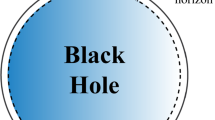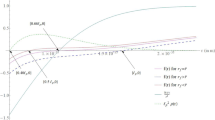Abstract
Using the Verlinde formalism, several scenarios for the evolution of the Friedmann–Robertson–Walker universe are considered, which are possible within the entropic cosmology based on a new modification of the Sharma–Mittal entropic measure. The study within the nonextensive statistical theory uses several entropic measures associated with the cosmological horizon due to the holographic data stored in it. Several versions of the generalized Friedmann equations have been constructed, which can serve as an effective theoretical basis for describing the dynamic evolution of a flat, homogeneous, and isotropic universe, generating diverse forms of matter contained in it. The approach proposed, which involves the use of probabilistic non-extensive aspects of the cosmological horizon, meets the well-known basic requirements for thermodynamic modeling of the dynamic behavior of outer space without involving the concept of hypothetical dark energy.
Similar content being viewed by others
Notes
In cosmology, holography is understood as information about the universe encoded on a surface screen located on the event horizon (a region of spacetime), which is treated as a two-dimensional surface of the universe (see, e.g., [37]).
According to the holographic principle, entropy is stored on holographic screens and the information increase associated with an increase in the surface of the universe occupied by material bodies leads to an entropy increase; hence the entropy (entropy force) gradient arises, directed against the increase along the radius of this surface.
The identification of the cosmological constant with the vacuum energy does not, unfortunately, give understanding of the essence of dark energy and leads to an as yet unsolvable problem, which is that the observed value of the dark energy density \({{\rho }_{{{{{{\Lambda }}}_{{{\text{obs}}}}}}}} \approx {{({{10}^{{ - 3}}}\;{\text{eV}})}^{4}}\), and its theoretically predicted value \({{\rho }_{{{{\Lambda }_{{{\text{th}}}}}}}} \approx {{10}^{{18}}}\;{{({\text{GeV}})}^{4}}\) differ by 120 orders of magnitude (here, is the potential of the scalar field \({v} = {v}(\varphi )\) (inflaton) [39].
Note that expression (7) coincides in absolute value with that which, according to some researchers, is the maximum possible force. At present, the possibility of the existence of a maximum value of force is rather lively discussed in the literature.
It should be noted that, when determining the Barrow entropy, the complex fractal structure of the cosmological horizon is simulated by an analogue of a spherical Koch snowflake, using an infinite decreasing hierarchy of touching spheres around the Schwarzschild event horizon. However, this simple model of the possible manifestations of quantum gravitational effects has important implications for estimates of the entropy of the universe, which is usually somewhat larger than in the basic scenario associated with Bekenstein–Hawking entropy.
As is known, space is flat (open) only if the ratio \(\Omega : = \rho {\text{/}}{{\rho }_{{{\text{cr}}}}} \cong 1\), where \({{\rho }_{{{\text{cr}}}}} = 3{{H}^{2}}{\text{/}}8\pi G\) is the critical density (matter + radiation) at which the transition from an open to a closed universe takes place. According to modern observational data, \(\Omega = 1.02 \pm 0.02\).
The value of H0 corresponding to the Planck spacecraft observations of cosmic microwave background (CMB) is H0 = 67.4 ± 0.5 (km/s)/Mpc [63]. At the same time, based on the Hubble telescope measurements of distances and redshifts of bright objects in relatively nearby galaxies: supernovae and Cepheids (“distance ladders”), the corresponding value is 73.3 ± 1.7 (km/s)/Mpc [64]. At the current stage of research, it is hardly possible to eliminate this difference (~9%), which significantly exceeds the accuracy of measurements, but it is of key importance in models of the evolution of the universe.
REFERENCES
E. J. Verlinde, High Energy Phys. 4, 1 (2011).
M. Akbar and R. G. Cai, Phys. Rev. D. 75, 084003 (2007).
T. Padmanabhan, Mod. Phys. Lett. A 25, 1129 (2010).
E. M. C. Abreu and J. A. Neto, arXiv: 2107.04869 v1 [gr-qc] (2021).
D. A. Easson, P. H Frampton, and G. F. Smoot, Phys. Lett. B 696, 273 (2011).
J. D. Bekenstein, Phys. Rev. D. 7, 2333 (1975).
S. W. Hawking, Commun. Math. Phys. 43, 199 (1975).
T. S. Koivisto, D. F. Mota, and M. Zumalacárregui, J. Cosmol. Astropart. Phys., No. 02, 027 (2011).
Y. S. Myung, Astrophys. Space Sci. 335, 553 (2011).
Y.-F. Cai, J. Liu, and H. Li, Phys. Lett. B 690, 213 (2010).
Y.-F. Cai and E. Saridakis, Phys. Lett. B 697, 280 (2011).
T. Qiu and E. N. Saridakis, Phys. Rev. D 85, 043504 (2012).
S. Basilakos, D. Polarski, and J. Sola, Phys. Rev. D 86, 043010 (2012).
D. A. Easson, P. H. Frampton, and G. F. Smoot, arXiv: 1003.1528 v3[hep-th] (2012).
N. Komatsu and S. Kimura, Phys. Rev. D 87, 043531 (2013).
N. Komatsu and S. Kimura, Phys. Rev. D 89, 123501 (2014).
A. D. Wissner-Gross and C. E. Freer, Phys. Rev. Lett. 110, 168702 (2013).
V. G. Czinner and H. Iguchi, Phys. Lett. B 752, 306 (2016).
H. Moradpour, Int. J. Theor. Phys. 55, 4176 (2016).
H. Moradpour, S. Sheykhi, C. Corda, and I. G. Salako, Phys. Lett. B 783, 82 (2018).
S. W. Hawking and G. T. Horowitz, Class. Quantum Grav. 13, 1487 (1996).
N. D. Keul, K. Oruganty, E. T. S. Bergman, N. R. Beattie, W. E. McDonald, R. Kadirvelraj, M. L. Gross, R. S. Phillips, S. C. Harvey, and Z. A. Wood, Nature (London, U.K.) 563, 584 (2018).
J. D. Brown, E. A. Martinez, and J. W. York, Phys. Rev. Lett. 66, 2281 (1991).
N. Komatsu, Phys. Rev. D 99, 043523 (2019).
A. Sayahian Jahromi, S. A. Moosavi, H. Moradpour, J. P. Morais Graça, I. P. Lobo, I. G. Salako, and A. Jawad, Phys. Lett. B 780, 21 (2018).
A. Sheykhi, Phys. Lett. B 785, 118 (2018).
Y. Aditya, S. Mandal, P. Sahoo, and D. Reddy, Eur. Phys. J. 79, 1020 (2019).
E. N. Saridakis and S. Basilakos, Eur. Phys. J. C 81, 644 (2021).
J. D. Barrow, S. Basilakos, and E. N. Saridakis, Phys. Lett. B 815, 136134 (2021).
U. K. Sharma, V. C. Dubey, A. H. Ziaie, H. Moradpour, and G. Kaniadakis, arXiv: 2106.08139 (2021).
A. V. Kolesnichenko and M. Ya. Marov, Math. Montisnigri 50, 80 (2021).
W. de Sitter, Proc. R. Acad. Sci. (Amsterdam) 19, 1217 (1917).
C. Tsallis and L. J. L. Cirto, Eur. Phys. J. C 73, 2487 (2013).
G. Kaniadakis, Phys. Rev. E 66, 056125 (2002).
J. D Barrow, Phys. Lett. B 808, 135643 (2020).
A. S. Jahromi, S. Moosavi, H. Moradpour, J. M. Graca, I. Lobo, I. Salako, and A. Jawad, Phys. Lett. B 780, 21 (2018).
L. Susskind, J. Math. Phys. 36, 6377 (1995).
F. K. Anagnostopoulos, S. Basilakos, and E. N. Saridakis, Eur. Phys. J. C 80, 826 (2020).
S. Weinberg, Cosmology (Oxford Univ. Press, Oxford, 2008).
R. C. Nunes, E. M. Barboza, E. M. C. Abreu, and J. A. Neto, J. Cosmol. Astropart. Phys., No. 08, 051 (2016).
B. D. Sharma and D. P. Mittal, J. Comb. Inform. Syst. Sci. 2, 122 (1975).
A. V. Kolesnichenko, Math. Montisnigri 42, 74 (2018).
E. M. C. Abreu, J. A. Neto, E. M. Barboza, Jr., A. C. R. Mendes, and B. B. Soares, Mod. Phys. Lett. A 35, 2050266 (2020).
F. K. Anagnostopoulos, S. Basilakos, G. Kofinas, and V. Zarikas, J. Cosmol. Astropart. Phys., No. 02, 053 (2019).
E. N. Saridakis, J. Cosmol. Astropart. Phys., No. 07, 031 (2020).
S. Waheed, Eur. Phys. J. Plus. 135, 11 (2020).
G. Wilk and Z. Wlodarczyk, Phys. Rev. Lett. 84, 2770 (2000).
J. W. Gibbs, Elementary Principles in Statistical Mechanics (Charles Scribner’s Sons, New York, 1960).
D. P. Zubarev, Non-Equilibrium Statistical Mechanics (Nauka, Moscow, 1971) [in Russian].
A. Renyi, in Proceedings of the 4th Berkeley Symposium on Mathematical Statistics and Probability (1961), Vol. 1, p. 547.
A. Renyi, Probability Theory (North-Holland, Amsterdam, 1970).
J. Havrda and F. Charvat, Kybernetika 3, 30 (1967).
Z. Daroczy, Inform. Control. 16, 36 (1970).
C. Tsallis, J. Stat. Phys. 52, 479 (1988).
T. D. Frank and A. R. Plastino, Eur. Phys. J. B 30, 543 (2002).
P. T. Landberg and V. Vedral, Phys. Lett. A 247, 211 (1998).
C. Tsallis, Introduction to Nonextensive Statistical Mechanics (Springer, New York, 2009).
T. S. Biró and V. G. Czinner, Phys. Lett. B 726, 861 (2013).
A. M. Scarfone and T. Wada, Phys. Rev. E 72, 026123 (2005).
E. Aktürk, G. B. Bagci, and R. Sever, arXiv: cond-mat/0703277 (2007).
A. V. Kolesnichenko, Statistical Mechanics and Thermodynamics of Tsallis of Non-Additive Systems. Introduction to Theory and Applications (LENAND, Moscow, 2019) [in Russian].
S. Weinberg, Rev. Mod. Phys. 61, 1 (1989).
N. Aghanim, Y. Akrami, et al., arXiv: 1807.06209 (2018).
A. G. Riess, S. Casertano, W. Yuan, et al., Astrophys. J. 876, 85 (2019).
I. D. Novikov, As the Universe Exploded (Nauka, Moscow, 1988) [in Russian].
A. Friedmann, Zeitschr. Phys. 10, 377 (1922).
R. G. Cai and S. P. Kim, J. High Energy Phys. 0502, 050 (2005).
S. Basilakos, M. Plionis, and J. Sola, Phys. Rev. D 80, 083511 (2009).
T. Padmanabhan and S. M. Chitre, Phys. Lett. A 120, 433 (1987).
X.-H. Meng and X. Dou, Commun. Theor. Phys. 52, 377 (2009).
B. Li and J. Barrow, Phys. Rev. D 79, 103521 (2009).
L. Sebastian, Eur. Phys. J. C 69, 547 (2010).
ACKNOWLEDGMENTS
The authors are grateful to the referees for their useful remarks.
Funding
This work was carried out within state assignment for the Keldysh Institute of Applied Mathematics and the Vernadsky Institute of Geochemistry and Analytical Chemistry, Russian Academy of Sciences, and was supported in part by the Ministry of Education and Science (grant no. 075-15-2020-780 dated 07.10.2020).
Author information
Authors and Affiliations
Corresponding author
Ethics declarations
The authors declare that they have no conflicts of interest.
Additional information
Translated by E. Chernokozhin
Rights and permissions
About this article
Cite this article
Kolesnichenko, A.V., Marov, M.Y. Friedmann Cosmological Equations in the Sharma–Mittal Entropy Formalism. Astron. Rep. 66, 786–799 (2022). https://doi.org/10.1134/S1063772922100080
Received:
Revised:
Accepted:
Published:
Issue Date:
DOI: https://doi.org/10.1134/S1063772922100080




